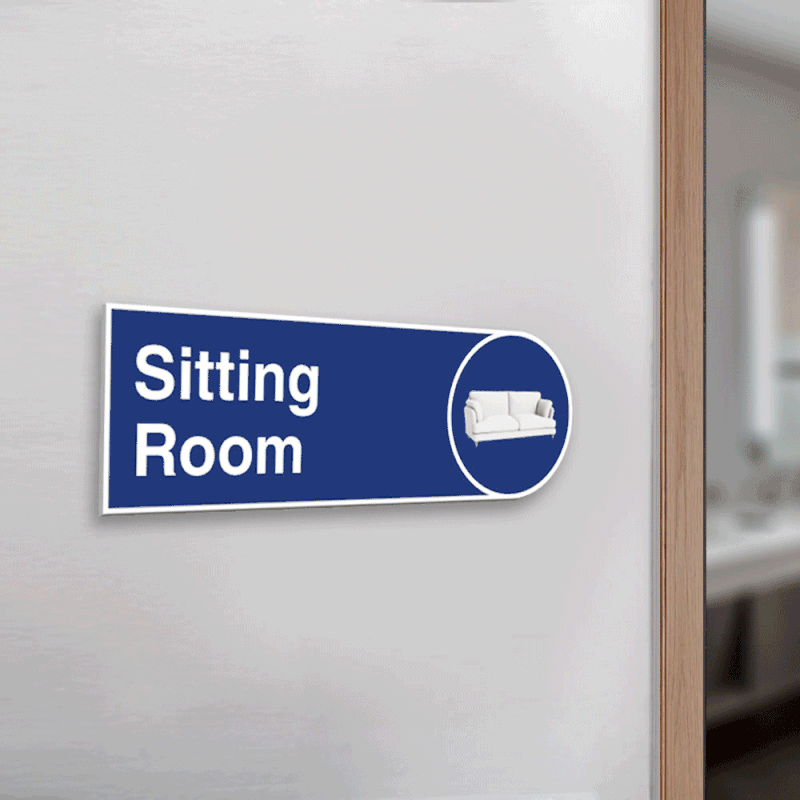
Signbox, specialists in Wayfinding solutions saw a gap in the market for dementia signage that complimented care home and residential interiors whilst also being specially designed for people with dementia to be easily understood and read clearly.
Signage as a powerful component in any wayfinding and orientation strategy is a given. With slick design, cutting-edge, planet-friendly materials and schemes that work in harmony with their environment, signs that make navigation exciting and intuitive will always rank high.
But, signs have a duty to be functional too – they’re there to fulfil the demands and ease the challenges of those who use that environment. Imagine life for those living with dementia who might also struggle with visual impairment, memory loss, balance and perception – and the way we look at signage becomes altogether more multi-dimensional.
How dementia friendly signage makes life in a care home safer and easier
Understanding the impact of dementia on everyday life gives a great insight into the factors we must consider when designing dementia-friendly signage for care homes.
- General and short term memory loss can make it difficult to recall where the bathroom or other personal spaces are.
- Visual impairments can affect how dark or light colours and contrasts appear and make it hard to read wording.
- Visuoperceptual problems can make peripheral vision narrower and make it hard for visually impaired people to see what’s happening to the side of them and can even lead to hallucinations.
All these problems can make life confusing and distressing for those with dementia, particularly those in new care home environments where the layout is unfamiliar and can all too often lead to falls and incontinence episodes. A care home should be a comfortable, safe and supportive place where signs are easy to follow and make moving around a gentle, rewarding activity.
The technical elements dementia friendly signage should always consider
It’s good to know that, despite the challenges highlighted above, dementia friendly signage that incorporates the following essential key technical elements will make wayfinding and orientation for people living with dementia easy and seamless.
High contrast ratios and light reflectance values (LRVs)
LRVs measure how much a surface reflects or absorbs – signs with very high LRVs make it easier for people living with dementia to see contrast and differentiate between text and pictures more clearly. The minimum recommended contrast ratio is between 60% and 70%.
Good colour contrasts
Good colour contrasts that use either shades of a colour or a more complex combination of colours using extremes of LRVs will make the difference between colours clearer. There should be a good colour contrast between the wall and the sign too – bold colours work best for dementia friendly signs and using different colours for different types of signs makes recognition easier. Avoid using yellow (unless it’s a hazard identifier or toilet) and multi-coloured pictures too – single coloured images with 3D rendering with plenty of surrounding space will give exactly the right contrast.
3D icons, text and images
People who live with dementia and visual impairment will require not only clear to read text, but the use of images shown in a 3D perspective. Images of this nature make it even easier to understand the sign when combined with the text. Text in upper and lower case letters are easier to read than in single case and lettering should always be 50% taller than normal signs.
Sign shape and materials
Using shapes to help identify a specific type of sign, such as the bathroom or medical room, can make finding the way around a care home a more familiar, reassuring process. Non-reflective surfaces also make for great dementia friendly signage because they’re much easier to read in the glare of bright lighting.
Lower sign position
People in wheelchairs and the elderly who can’t look up easily or have lost height in old age can struggle to see signage if it’s positioned too high. The best height for dementia friendly signage is 1.2m–1.4m from the floor.
The Signbox range of dementia friendly signage make life better for care home residents
It’s important to incorporate all these technical features in a dementia friendly signage strategy. You’ll not only make it easier for care home residents who live with dementia to find their way around, you’ll be improving their quality of life too. Environments that are easy to navigate can reduce slips, trips and falls, incontinence episodes and the distress and agitation that comes with feeling lost.
In the process, you’ll improve their feelings of independence, dignity and confidence as they feel better able to move around and interact socially with their fellow residents – and all that extra activity can do wonders for appetite and mobility.
If you’re considering a signage scheme for your care home, take a look at our full range of dementia friendly signs on our eShop HERE. If you’d like help on what would work best for your care home environment, please get in touch with our specialist team on 44 (0) 1784 438 688 and we’ll talk you through your options.




 European Sign Federation
European Sign Federation